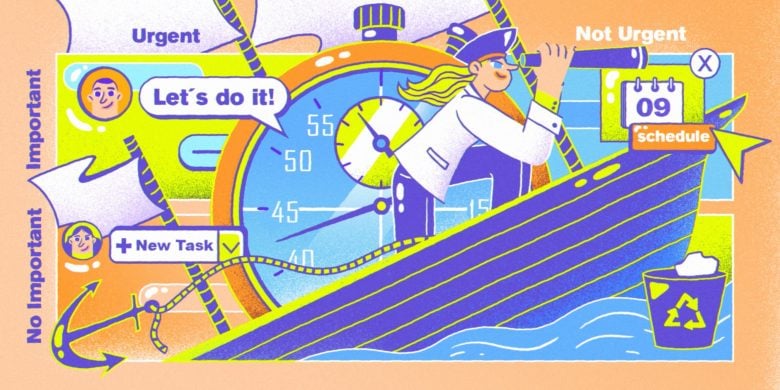We’re always on the hunt for good books on working better.
If it covers efficiency, time management, leadership, and remote teams, we’re all ears.
That explains why we enjoyed, It Doesn’t Have to Be Crazy at Work by Jason Fried and David Heinemeier Hansson, founders of Basecamp.
And because we love sharing findings with you, fellow productivity fans, we’ve compiled our top learnings, and how we’re applying them at Hubstaff.
Boost your team’s efficiency with Hubstaff's productivity tools
1. Great work demands uninterrupted time
You don’t have to read too far to reach the first nugget of wisdom: most time is wasted on things that don’t matter.
Routine, mundane tasks eat up too much of our days, keeping us from focused time on important tasks.
Having less meaningless work is the best way to get more important work done.
Because, “Great work demands uninterrupted time.”
This is something that we believe in deeply at Hubstaff. We want to provide our team with an environment for this to happen.
Our recommendation from this learning was the following, which was sent out over Slack:
If you find yourself constantly being interrupted, please contact your manager and ask them to help solve the issue.
Want to find more uninterrupted time in your day? Ask yourself the following:
- How many items in a day do you participate in that do not bring in real results?
- Is there more time spent on some things that are higher impact?
Make a list, scrub your schedule, and enjoy more time on important work.
2. Time is your most valuable resource

You might know this one, especially if you appreciate great time management. Here it is:
Employee time and attention is the most important and scarce resource in a company.
If you’re a business owner or leader in an organization, it’s your job to protect this.
How?
Treat your own time and your team’s time as a very precious resource.
- Model the behaviors you want your organization to embody, such as setting aside interruption-free work time (check out time blocking)
- Cut out unneeded work
- Choose written status updates over status meetings
When you make time only for the most important work, you’ll quickly see which tasks aren’t worth the time or effort.
Here at Hubstaff, we encourage everyone to stop working on tasks that bring 0 results. This especially comes into play when deciding on priorities for the upcoming quarter.
If something isn’t going to bring us closer to our goals, it’s not worth the time investment.
Another idea from the book that we’ve put into practice is the daily and weekly status updates.
Instead of holding regular meetings, each person posts what they worked on that day. There’s a written record of where projects are at, and managers can quickly see what their team is working on. We use Hubstaff Tasks and create a “Team Updates” board for this.

3. Embrace JOMO
FOMO is so 2018. This year is all about JOMO — the joy of missing out.
That sound you hear is all your introverted team members quietly cheering.
Kidding aside, this thinking can open new doors to better work.
When you think about your organization, you should encourage people to want to miss out. This is what allows people to get good work done.
One time culprit can be group chat. That little green dot can make it easy to interrupt a team member at any time. This is important for both managers and employees to know.
Instead of defaulting to a chat message, ask yourself if you need to bother someone. And if you do send a message, don’t expect an immediate response.
Give your team the authority to work first and respond to chat messages second. If someone doesn’t respond, it’s likely because they’re doing their job.
Constant interruption and the potential to hear a “ding!” at any time can lead to more stress. Be cautious of this, and talk to your team if they feel bound to your chat software.
One analogy we loved from the book:
“Following group chat is like being in an all-day meeting with no agenda.”
Now doesn’t that sound wonderful?
4. Always iterate
A brief but important point from the book: Like products, you have to keep continually tweaking companies.
Don’t be married to one thing, especially if at any time it stops working for you.
Hubstaff is a small, growing company. Many times, we don’t know what is going to work, so we find ourselves changing gears from time to time, and that’s ok.
It’s better than the alternative, which would be committing to something that doesn’t work time and time again.
5. Be effective, not busy
Next, some math. 1 x 60 and 6 x 10 both = 60 minutes.
But, 1 x 60 is much more powerful because it means you can focus for more time at once.
The lesson here is don’t underestimate the importance of focus.
In business culture, and especially startup culture, you can be fooled into thinking “busy” is the same as effective.
Someone whose day is full, who is working 80 hours a week, and who is going to industry events even after work hours can give off the impression of success. And for some, this is true.
But busy is not the goal. Results are.
Productivity can become a similar buzzword, especially when the output of productivity isn’t the goal.
The book warns against “the hustle,” or the need to be constantly working. Taking time to recharge is a benefit to every single person in the workforce. Check out the book’s essay called, “Bury the Hustle.”
Another way to judge your work is by your work ethic.
Good work ethic means doing what you say you are going to do, putting in a fair day’s work, respecting the work, respecting the customer and your coworkers, not wasting time, not creating unneeded work for others, and not being a bottleneck.
How many of those can you say you do on a regular day? Take a minute to assess and see where you could improve.
6. Make it difficult to schedule meetings
This one might spark some discussion at your office or Slack channel if you’re remote like us.
Meetings should be a last resort.
The team at Basecamp makes it very difficult to schedule meetings. On purpose. The goal is to keep people out of meetings so they have more time in their day for work.
Interested? Here’s how to do it:
- No shared calendars
- Don’t invite people to meetings if they don’t need to be there
- Develop criteria for calling a meeting (Ex: is there an agenda? What is the goal?)
We’ll even invite others into a meeting once it’s started if we decide we need more input. Defaulting to fewer people from the beginning can help you stay focused on what needs to get done, and doesn’t waste anyone’s time who is not contributing.
Basecamp said the company can feel good about not requiring people to work as many hours because they’re not stuck in meetings all day.
Sounds like a win-win to us.
One final thought: If you don’t own the majority of your time, you are always going to feel robbed and stressed out.
Want to read more? Check out our post on seven factors of productive meetings.

7. Do nothing
It’s exactly what it sounds like. Well, not exactly. Here’s what we learned:
“Doing nothing is a choice, and in many cases, the best one.”
Sometimes change can make things worse. Any founders out there who can attest to that?
When you decide to change something, you need to consider all the work that needs to be done, and all the other things you need to say no to in order to do this work.
Doing nothing is many times better than trying to do a lot of work that doesn’t matter. This goes back to the idea of focusing on what brings results.
You’ll hear the term “low-hanging fruit” as a place to start. As the book explained, low hanging fruit looks low when you are a long way away from the work. But when you get closer, it’s almost always harder and takes more time than expected.
Even the simplest tasks take time and money so be selective about what you’re going to take on.
At Hubstaff, we’ve tried a number of small initiatives that returned no results for us. Even worse, they should have been easy. Instead, these tasks required lots of work and were ultimately abandoned.
Lesson learned.
8. Think of trust as a battery that needs to be charged
A common topic when discussing remote work is trust.
How do you find remote talent you can trust, foster connections between colleagues, and onboard team members in a way that builds trust?
For us, we find that trust just happens.
Fried and Heinemeier Hansson put it another way:
Trust is a battery.
When you hire someone, the battery starts at 50%. Every time you work with them, it either gets charged or loses charge.
We’ve noticed this at Hubstaff, as well. It’s part of the reason we do test projects, which is also mentioned in the book. Not only do you get to see how prospective hires handle a challenge, but you get to see their thinking and way of working in a real-life application.
You could also have a trial period, which gives both the manager and team member a chance to see how it goes — no commitment necessary.
Want to level up?
Subscribe to the Hubstaff blog and get the best articles on leadership, productivity, and remote work.
9. Avoid unnecessary check-ins
Ah, the status meeting. Is it time to retire them in 2019? We sure hope so.
It’s not just because of the on-hold music.
It’s because, as the book states, trying to know every detail is stressful and, a waste of time and brainpower.
Instead, try “heartbeats.” These monthly summaries of work are submitted as text updates. Anyone can review at the time they’re posted, or go back and look at previous months.
This format lets your team review and update each other on their time, so no one is sitting in a meeting with nothing to share.
10. Think about how you structure projects
This book does a great job of offering big picture thinking next to practical advice.
One section of specific guidance was around how you set up and plan projects. Here are the highlights, should you want to take any one idea and run with it:
- Work on projects in 6-week cycles
- This can bring new things to the surface, and gives a deadline to every project
- Work in teams of 2-3
- We saw success in this group size during our retreat hackathon
- Keep it flat
- Basecamp is largely manager-free. People set their own short- and medium-term direction, and only receive small bits of feedback from the top
- Give projects a finite start and end date
- Present work in well-prepared documents
- This gives your team a chance to consume the entire idea before giving feedback

Scratching the surface of efficient work
While we’ve gathered our 10 favorite points from the book, this doesn’t begin to cover what you’ll find in It Doesn’t Have To Be Crazy At Work.
Give it a read, and let us know what you liked best.
Most popular
The Fundamentals of Employee Goal Setting
Employee goal setting is crucial for reaching broader business goals, but a lot of us struggle to know where to start. American...
Data-Driven Productivity with Hubstaff Insights: Webinar Recap
In our recent webinar, the product team provided a deep overview of the Hubstaff Insights add-on, a powerful productivity measurem...
The Critical Role of Employee Monitoring and Workplace Security
Why do we need employee monitoring and workplace security? Companies had to adapt fast when the world shifted to remote work...
15 Ways to Use AI in the Workforce
Whether through AI-powered project management, strategic planning, or simply automating simple admin work, we’ve seen a dramatic...




